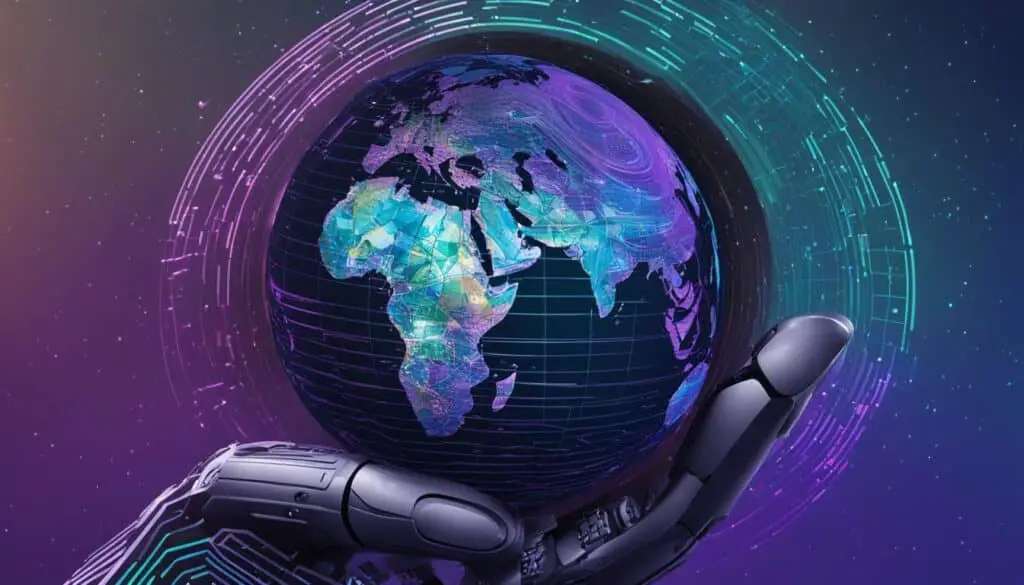
In today’s hyper-connected world, the ability to effectively communicate with people who speak different languages is crucial. However, language barriers can be a major obstacle. Translation and localization, powered by AI, are revolutionizing the way content is translated and localized. AI-powered translation tools can perform tasks like text translation, voice recognition, and natural language processing. This section will explore the impact of AI on content translation and localization and how it is changing global communication.
Key Takeaways:
- AI-driven language translation and localization are transforming global communication.
- AI-powered tools enable quick and accurate translation, enhancing productivity.
- Natural Language Processing (NLP) is a key component of AI language translation and localization.
- AI makes translation and localization more accessible, allowing businesses to reach diverse markets.
- While AI offers numerous benefits, there are challenges to address, such as contextual understanding and quality control.
The Evolution of Content Translation and Localization
Throughout history, language translation and localization have played a crucial role in bridging the communication gap between different cultures. From ancient times, when translators were needed for religious texts and diplomatic messages, to the modern era of machine translation and computer-assisted tools, the evolution of this field has been remarkable. Now, with the advent of Artificial Intelligence (AI) and Natural Language Processing (NLP), translation and localization are undergoing rapid transformation, revolutionizing the way content is adapted for global audiences.
AI-powered translation tools are capable of accurately translating entire texts in seconds, spanning numerous languages. These tools utilize NLP and machine learning algorithms to recognize and understand the nuances of language, including idioms, cultural references, and context-specific meanings. This level of sophistication greatly enhances the accuracy and quality of translated content, surpassing the capabilities of traditional human translators alone.
“AI-powered translation tools accurately translate entire texts in seconds, recognizing idioms, nuances, and cultural references.”
Moreover, AI technology has significantly improved the speed and efficiency of the translation and localization process. With AI-driven language adaptation, businesses and individuals can now translate their content into multiple languages with ease. This accessibility ensures that language is no longer a barrier to communication and facilitates global expansion opportunities for companies across various industries.
Although AI has brought tremendous advancements to content translation and localization, there are challenges that need to be addressed. The risk of over-relying on machine translation can lead to inaccuracies and loss of contextual understanding. Additionally, ethical considerations must be taken into account, such as ensuring that sensitive or culturally significant content is accurately translated and localized without causing offense or misrepresentation.
| Advantages of AI in Translation and Localization | Challenges and Considerations |
|---|---|
| Increased speed and efficiency | Risk of over-reliance on machine translation |
| Improved accuracy | Ethical considerations in sensitive or culturally significant content |
| Enhanced accessibility for multilingual content |
Despite these challenges, there is no denying the transformative impact of AI on the field of content translation and localization. As AI technology continues to advance, we can expect even more exciting developments that further break down language barriers and connect people from different parts of the world.

How AI is Transforming Content Translation and Localization
In the world of content translation and localization, AI is playing a pivotal role in driving efficiency and accuracy. Through AI-driven language adaptation, the process of translating and localizing content has become faster and more accessible than ever before. AI-powered tools are revolutionizing the way businesses and individuals communicate globally, bridging language barriers and connecting people from different cultures.
One of the key benefits of AI in content translation and localization is its ability to increase speed and efficiency. AI-powered tools can quickly translate texts, reducing turnaround times and enabling businesses to reach wider audiences in a shorter amount of time. The machine learning algorithms used in AI also allow for continuous improvement, as the tools recognize patterns and nuances in language, resulting in more accurate translations.
Furthermore, AI makes multilingual translation and localization more accessible to businesses and individuals. With AI, businesses can easily translate their content into multiple languages, expanding their reach to global markets. This not only facilitates better communication with customers but also enhances customer experiences by providing localized content that resonates with specific target audiences.
However, it is important to acknowledge the challenges that come with AI-powered translation and localization. While AI is incredibly powerful, there is still a risk of over-relying on machine translation. Contextual understanding and quality control can be challenging for AI, as it may struggle to accurately capture the nuances and cultural references in a given language. Additionally, ethical considerations must be taken into account when using AI for translation and localization.
Despite these challenges, there is no denying the transformative impact of AI on content translation and localization. As technology continues to advance, we can expect even more exciting developments in the field, breaking down language barriers and fostering global communication.

Table: Benefits of AI in Content Translation and Localization
| Benefits | Description |
|---|---|
| Increased Speed | AI-powered tools can quickly translate texts, reducing turnaround times and enabling businesses to reach wider audiences in less time. |
| Improved Accuracy | Through machine learning algorithms, AI tools recognize patterns and nuances in language, resulting in more accurate translations. |
| Enhanced Customer Experiences | AI enables businesses to provide localized content that resonates with specific target audiences, enhancing customer experiences. |
| Greater Accessibility | AI makes multilingual translation and localization more accessible, allowing businesses to easily translate content into multiple languages. |
Conclusion
In conclusion, the integration of AI in language translation and localization has brought about significant advancements in global communication. AI-powered tools have proven to be invaluable in overcoming language barriers and facilitating effective communication across different cultures and languages.
The use of AI in content translation and localization has revolutionized the speed and efficiency of the translation process. With AI algorithms continuously improving, translations are becoming not only faster but also more accurate. This has led to reduced turnaround times, increased productivity, and cost savings for businesses.
Furthermore, AI-driven translation and localization solutions enable businesses and individuals to easily adapt their content to multiple languages and target specific markets. This accessibility has opened up new opportunities for global expansion and enhanced customer experiences.
While AI has undoubtedly transformed the field of content translation and localization, challenges remain. Contextual understanding and quality control are areas that still require attention. Nevertheless, as AI technology continues to evolve, we can anticipate further breakthroughs in breaking down language barriers and connecting people worldwide.
FAQ
How is AI revolutionizing content translation and localization?
AI-powered tools increase speed and accuracy, reduce turnaround times, and make translation and localization more accessible.
What is the history of content translation and localization?
Content translation and localization can be traced back to ancient times, when translators were needed for religious texts and diplomatic messages.
What are the benefits of using AI in language translation and localization?
AI-powered tools increase speed, efficiency, and accuracy, reduce costs, and enhance customer experiences by facilitating localization for specific markets.
What are the challenges in AI-powered content translation and localization?
Challenges include contextual understanding and quality control, as well as the risk of over-relying on machine translation.
How is AI changing the landscape of content translation and localization?
AI is transforming the field by increasing speed and accuracy, making translation and localization more accessible, and breaking down language barriers.
Source Links
- https://www.motionpoint.com/blog/the-role-of-ai-and-machine-learning-in-translation/
- https://aicontentfy.com/en/blog/impact-of-ai-on-content-translation-and-localization
- https://localizejs.com/articles/artificial-intelligence-and-localization-how-ai-is-changing-the-landscape/








